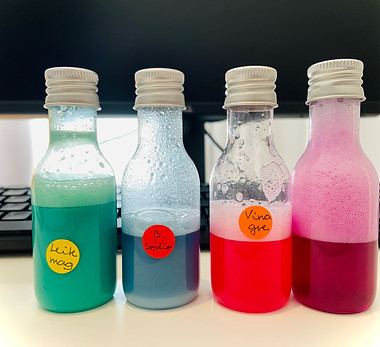
Chemistry
I have been teaching chemistry since the age of 18, gaining extensive experience with diverse age groups, from middle school students to university undergraduates. As an educator, I prioritize establishing connections between theoretical concepts and real-world applications, particularly through dynamic laboratory activities that enhance learning.
My primary motivation is the engagement and enthusiasm displayed by my students during hands-on experiments. During lab activities, I emphasize observation as chemistry revolves around transformations. To truly understand these changes, students must actively observe the reactions taking place.
Below, you will find a selection of photographs and descriptions of various activities I have facilitated in my classes.
Burning steel wool

In this activity, students analyzed both qualitative and quantitative changes in a piece of steel wool before and after it was burned. This hands-on experience allowed them to grasp the visual aspects of chemical transformations while also applying the principle of conservation of mass.
Gas production

A good and simple way to teach chemical transformations is by taking students to the lab and performing experiments that allow them to observe changes. In this activity, they observed the chemical reaction between baking soda and vinegar. By changing the amount of baking soda, they also could understand proportions and limiting reactants
Making soap

From middle school to higher education, soap-making is one of the most enriching experimental activities in chemistry. It opens up numerous opportunities for exploration within the field. I've utilized this activity at various educational levels to examine the chemistry behind soap, including molecular interactions, physical changes, and saponification reactions. Depending on the grade level and time available, I also encourage students to create their unique scents to incorporate into their soap.
Essential oil extraction

When teaching topics like molecular interactions, organic functional groups, or mixtures, I often use the production of essential oils as a hands-on activity to illustrate the chemistry behind fragrances. I invite students to choose plant materials from which they'd like to extract scents and guide them through the process using various solvents. They carry out the extraction, compare the results, and determine which solvent is most effective. The main goal is to explore how molecular interactions and organic functional groups influence the aroma of each extract.
Organic dyes and pH

In this activity, students explored how the color of organic plant extracts can change with pH, revealing the presence of natural pH indicators such as anthocyanins. By adjusting the pH of the extraction medium using acids and bases, they observed visible shifts in color. This experiment helped them understand the chemical basis behind why certain flowers, like hydrangeas, change color depending on the pH of the soil, which affects the protonation state of pigment molecules.
Acids and bases

During the COVID-19 pandemic, teaching basic science concepts was especially challenging due to limited access to lab resources. To address this, I created a hands-on experiment using red cabbage extract as a natural pH indicator. I prepared and distributed kits with household materials like vinegar, baking soda, and soap, allowing students to observe color changes and explore the pH scale from home. This activity made learning more accessible, engaging, and meaningful during remote learning.
Sugar crystals

To explore chemical concepts in a fun and accessible way, I asked students to grow sugar crystals at home. Using basic materials like sugar and water, they investigated solubility, saturation, and the crystallization process. This simple yet engaging experiment helped students connect everyday experiences to core chemistry concepts during remote learning.
Catalysts

Elephant toothpaste is the classic experiment I use to wrap up my lessons on catalysts. While I incorporate various activities to explore catalytic reactions, this one is by far the most visually striking, with the rapid foam eruption grabbing students' attention. I save it for the end because it’s a memorable way to discuss different types of catalysts and their real-world applications.
Complexatoin

There are many ways to teach metal complexation, but my favorite is using hemoglobin as an example to demonstrate redshift due to ligand replacement. When oxygenated, hemoglobin appears bright red, and when deoxygenated, it turns a purplish color. This visual contrast helps students understand the chemistry of inorganic complexes and their relevance in our daily lives.
Chromatography

One of my favorite activities for teaching separation techniques is chromatography with felt-tip pens. By applying ink to paper and using a solvent to separate the colors, students observe how different components travel at different rates. This hands-on demonstration helps them grasp the principles of chromatography and its applications in fields like forensics and chemistry.
Silver cleaning

In this activity, I asked students to bring in a silver item to the class so we could clean it using the chemical principles of redox reactions. By applying a reducing agent, we demonstrated how silver tarnish (silver sulfide) can be removed through a simple redox process, where silver ions are reduced, and the tarnish is oxidized. This hands-on experience not only reinforces the concept of redox reactions but also shows their practical applications in everyday life, helping students connect chemistry to real-world processes
Solutions and dispersions

In this activity, students investigated the passage of light through various solutions, including milk, to explore the properties of different types of solutions. By shining light through each solution and observing how the light intensity changed, we were able to discuss concepts like transparency, scattering, and absorption. The milk, in particular, provided an interesting example of a colloidal solution, where light is scattered due to the suspended particles. This hands-on investigation helped students understand the behavior of light in different mediums and reinforced the idea of solution types in chemistry
